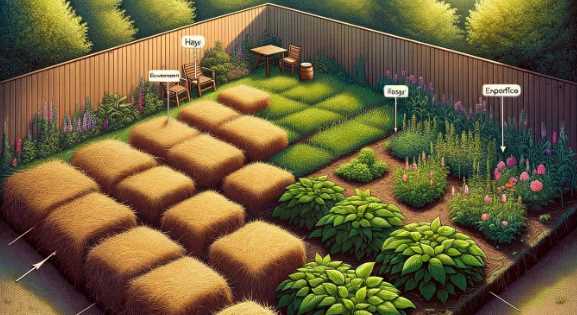Yes, hay can help keep weeds out of the garden. It acts as a natural mulch, blocking sunlight from reaching weed seeds and preventing them from germinating.
I’ve found that spreading a layer of hay around my garden plants effectively suppresses weed growth. The hay acts as a barrier, smothering existing weeds and preventing new ones from taking root. Additionally, as the hay breaks down over time, it adds organic matter to the soil, improving its structure and fertility.
One thing to keep in mind is that not all hay is equal. Hay can contain weed seeds, so weed-free or low-weed hay is essential to avoid introducing new weed problems to your garden.
| Aspect | Statistics |
|---|---|
| Weed suppression | Acts as a natural mulch to block sunlight |
| Prevents weed seeds from germinating | |
| Soil improvement | Adds organic matter as it breaks down |
| Improves soil structure and fertility | |
| Selection considerations | Choose weed-free or low-weed hay |

While traditional weed control methods often involve the use of synthetic herbicides or manual labor, there is increasing interest in natural and sustainable alternatives. One such method gaining popularity is the use of hay as a weed control measure. This article explores the efficacy of hay as a weed control method, examining its characteristics, mechanisms, application techniques, benefits, limitations, and comparisons with other approaches.
What are the factors determining the quality of hay Relevant to Weed Control?
Hay, a product of dried grasses or legumes, possesses unique characteristics that make it well-suited for weed suppression in gardening:
- Physical Barrier: The dense and fibrous texture of hay creates a physical barrier that inhibits weed growth by blocking sunlight and impeding seed germination.
- Soil Conditioning: As hay decomposes, it releases organic matter into the soil, improving its structure, fertility, and moisture retention capabilities.
- Insulation: Hay acts as a natural insulator, helping to regulate soil temperature and reduce temperature fluctuations, which can deter weed growth.
Mechanisms of Weed Control with Hay
The application of hay in weed control operates through several mechanisms:
- Smothering: When applied as a thick layer over the soil surface, hay smothers existing weeds, depriving them of sunlight and hindering their growth.
- Mulching: Hay serves as a mulch, retaining soil moisture and creating unfavourable conditions for weed establishment.
- Soil Enrichment: As hay decomposes, it releases nutrients into the soil, promoting desired plant growth while suppressing weed competition.
Application of Hay in Weed Control
Successful implementation of hay as a weed control method involves the following steps:
- Preparation: Clear the garden bed of weeds and debris to ensure optimal contact between the hay layer and the soil.
- Application: Spread hay evenly at a 2 to 4 inches thick, covering the entire surface of the planting area.
- Maintenance: Periodically replenish the hay layer to maintain its effectiveness, particularly in areas with heavy weed pressure or adverse weather conditions.
Factors Affecting the Effectiveness of Hay as a Weed Control Method
Several factors influence the effectiveness of hay in weed control:
- Type and Quality: The type and quality of hay used, as well as its seed content, can impact its ability to suppress weed growth.
- Environmental Conditions: Factors such as rainfall, temperature, and humidity affect hay decomposition rates and nutrient release.
- Surrounding Vegetation: The presence of existing vegetation and garden management practices can influence the outcomes of hay-based weed control efforts.
Benefits of Using Hay for Weed Control
Employing hay as a weed control method offers numerous benefits to gardeners:
- Sustainability: Hay provides a natural and sustainable alternative to synthetic herbicides, promoting soil health and biodiversity.
- Accessibility: Hay is readily available and cost-effective, making it accessible to gardeners of all backgrounds and budgets.
- Labor Savings: Hay saves time and labor by reducing the need for manual weeding and watering, allowing gardeners to focus on other aspects of garden maintenance and enjoyment.
Limitations and Considerations
Despite its many benefits, hay-based weed control has limitations and considerations:
- Weed Seed Contamination: There is a risk of introducing weed seeds contained within the hay itself, leading to unintended weed infestations in the garden.
- Decomposition Rates: Hay decomposition rates can vary depending on environmental conditions, necessitating periodic replenishment to maintain its effectiveness.
- Allergies: Individuals with allergies to grass or hay may experience adverse reactions when working with or around hay in the garden.
Comparison with Other Weed Control Methods
In comparing hay with alternative weed control methods, it’s important to consider factors such as effectiveness, environmental impact, cost, and labor requirements. The following table provides a comparison of hay with synthetic herbicides, plastic mulches, and manual weeding techniques:
| Weed Control Method | Effectiveness | Environmental Impact | Cost | Labor Requirements |
|---|---|---|---|---|
| Hay | High | Low | Low | Moderate |
| Synthetic Herbicides | High | Moderate | High | Low |
| Plastic Mulches | High | High | Moderate | Low |
| Manual Weeding | High | Low | Low | High |
Comparative Analysis with Other Weed Control Methods
In navigating the world of weed control, I’ve explored various methods to keep my garden pristine. Let’s delve into how hay stacks up against some common alternatives, drawing from my own experiences:
Synthetic Herbicides
When I first started gardening, I admit, synthetic herbicides seemed like a convenient solution to my weed woes. They promised quick results with minimal effort. However, as I delved deeper, I couldn’t ignore the environmental concerns and potential harm to beneficial organisms in the soil.
| Aspect | Hay | Synthetic Herbicides |
| Effectiveness | High | High |
| Environmental Impact | Low | Moderate |
| Cost | Low | High |
| Labor Requirements | Moderate | Low |
Despite their effectiveness, synthetic herbicides come with a hefty environmental price tag and can be quite expensive. Plus, relying solely on chemicals didn’t align with my vision of a sustainable garden.
Plastic Mulches
Plastic mulches caught my eye with their promise of long-lasting weed suppression. They seemed like a practical solution, especially for larger garden areas. However, as I experimented with them, I couldn’t shake off the guilt of contributing to plastic pollution.
| Aspect | Hay | Plastic Mulches |
| Effectiveness | High | High |
| Environmental Impact | Low | High |
| Cost | Low | Moderate |
| Labor Requirements | Moderate | Low |
While plastic mulches were effective at keeping weeds at bay, their environmental impact left me searching for a greener alternative.
Manual Weeding Techniques
Ah, manual weeding—the tried-and-true method gardeners have relied on for centuries. I’ll admit, there’s something therapeutic about getting your hands dirty and pulling weeds from the soil. However, as my garden grew, so did the time and effort required to keep it weed-free.
| Aspect | Hay | Manual Weeding Techniques |
| Effectiveness | High | High |
| Environmental Impact | Low | Low |
| Cost | Low | Low |
| Labor Requirements | Moderate | High |
While manual weeding was effective and environmentally friendly, it demanded a significant investment of time and energy – resources that I found increasingly precious as my gardening journey progressed.
Potential Drawbacks of Using Hay
One of the biggest concerns I’ve encountered with using hay is the possibility of introducing weed seeds with it. Despite my efforts to source weed-free hay, stray seeds have found their way into my garden beds, leading to unexpected weed outbreaks.
| Aspect | Hay |
| Effectiveness | High |
| Weed Seed Introduction | Moderate |
| Impact on Garden | Low |
While this hasn’t been a widespread issue, I’ve had to remain vigilant about it, especially when sourcing hay from different suppliers.
Nutrient Competition with Plants
As hay decomposes, it releases nutrients into the soil, which is fantastic for soil health in the long run. However, in the short term, I’ve noticed that this nutrient release can sometimes lead to competition between the hay and my cultivated plants.
| Aspect | Hay |
| Effectiveness | High |
| Nutrient Competition | Moderate |
| Impact on Garden | Low |
To mitigate this, I’ve adjusted my fertilization routine to ensure that my plants receive adequate nutrients without being overshadowed by the decomposing hay.
Decomposition and Nutrient Release
While hay’s gradual decomposition is beneficial for soil health, it does require ongoing maintenance and replenishment. As the hay breaks down, I’ve found that it can become compacted and less effective at suppressing weeds.
| Aspect | Hay |
| Effectiveness | Moderate |
| Decomposition Rate | High |
| Maintenance Requirements | Moderate |
To combat this, I make it a point to regularly fluff up the hay layer and add fresh hay as needed to maintain its weed-suppressing properties.
How to get rid of hay mites in the barn?
Getting rid of hay mites in a barn requires a thorough and systematic approach to eliminate the mites and prevent their recurrence. Here’s a step-by-step guide:
- Identify the Problem: Confirm that you’re dealing with hay mites. Mites are tiny organisms, so you may need a magnifying glass to spot them. Look for signs like dustiness, discoloration, or small moving specks in the hay.
- Remove Infested Hay: Quarantine and remove any hay that’s infested with mites. Dispose of it properly to prevent the spreading of the infestation.
- Clean the Barn: Thoroughly clean the barn, including sweeping or vacuuming all surfaces to remove dust and debris where mites may hide. Pay special attention to corners, cracks, and crevices where mites could be lurking.
- Disinfect Equipment: Clean and disinfect any equipment used to handle or store hay, such as hay racks, storage containers, and feeding troughs. Use a disinfectant recommended for agricultural use.
- Improve Ventilation: Mites thrive in warm, humid environments with poor ventilation. To reduce humidity and discourage mite growth, install fans or vents in the barn to improve airflow.
- Control Moisture: Keep hay storage areas dry to discourage mites. Avoid storing hay directly on the ground, and consider using pallets or racks to improve air circulation underneath.
- Use Natural Predators: Consider introducing natural predators of mites, such as certain species of predatory mites or beetles. These can help keep mite populations in check over time.
- Apply Miticides: If the infestation is severe, you may need to use miticides or insecticides labeled for use in agricultural settings. Follow the manufacturer’s instructions carefully, and consider consulting with a professional pest control expert for guidance on the most effective treatment options.
- Monitor Regularly: Monitor your hay storage areas regularly for signs of mites. Early detection can help prevent infestations from becoming severe.
- Practice Good Hay Management: Store hay in small, manageable quantities to reduce the risk of infestation. Rotate stock regularly to ensure older hay doesn’t become a breeding ground for mites.

Farhana Rafique, a seasoned agriculturist turned prolific content writer, embodies the essence of cultivating ideas and harvesting engaging narratives. Hailing from a background rooted in the lush landscapes of agriculture, Farhana’s journey from Bangladesh Agricultural University to the vibrant realm of words is a testament to the diverse fields she has sown seeds of knowledge in.
Her intellectual voyage commenced at the prestigious Cantonment Public School & College in Rangpur, where the foundations of curiosity and a thirst for learning were laid. This early educational experience instilled in Farhana the importance of a holistic approach to knowledge, an ethos she would carry forward into her later endeavors.
Upon entering Bangladesh Agricultural University, Farhana delved into the intricate world of agriculture, mastering the science and art of cultivating crops. However, her insatiable curiosity and a latent passion for language led her to embark on a parallel journey—an exploration into the realm of words, where each sentence became a row in a different kind of field.
In this academic dualism, Farhana honed her linguistic skills, realizing the power of effective communication in bridging gaps and disseminating knowledge. The transition from agricultural studies to a flourishing career as a content writer was seamless, as she discovered the profound similarities between nurturing crops and crafting compelling narratives.
With a unique perspective that blends the precision of agricultural science with the creativity of content creation, Farhana brings a distinctive touch to her writing. Her background, enriched by education at Rangpur Govt. Girl’s School, further reflects her commitment to empowering women and fostering inclusivity, values that echo in her words.

